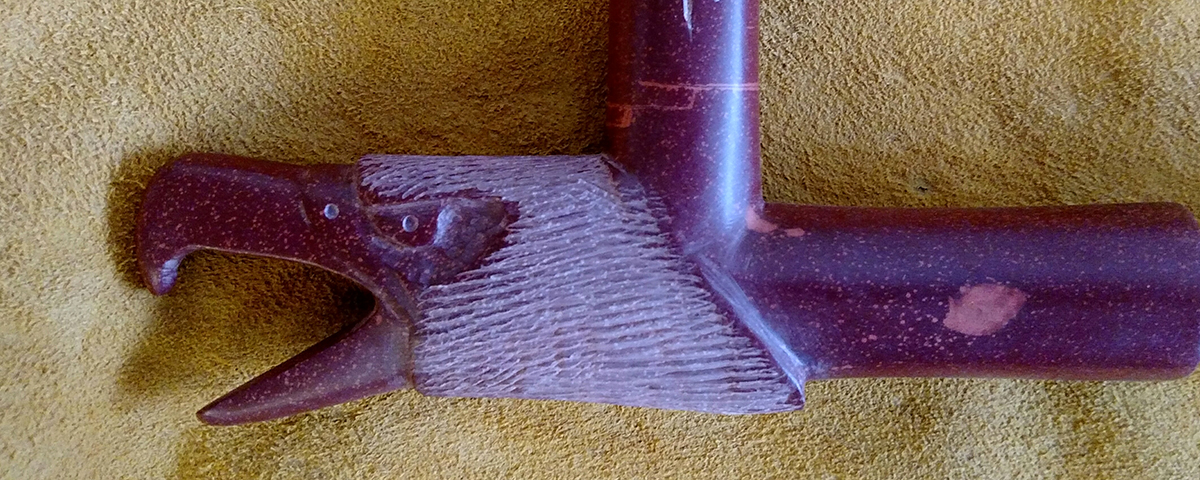The methodical cadence of steel on steel rings out on a warm June evening. In a pit 18 feet below the surface of the tallgrass prairie Travis Erickson delivers well-placed strikes with a sledgehammer to a deftly positioned wedge. After several powerful blows a thick slab of pipestone breaks from the rock formation.

Travis, a member of the Sisseton Wahpeton Oyate and a fourth-generation Sioux pipe maker, leans the sledgehammer against the quartzite wall of his one-man quarry at Pipestone National Monument in southwestern Minnesota (see related feature) and hefts the pipestone slab. “I like working with the bottom pipestone layer the best,” he explains. “It’s the hardest. I can do lots of detail work with the bottom layer. It has a nice, illuminating red luster.”
Travis, whose great-grandfather Moses Crow settled in the area in 1927 to quarry and carve the rock, has been hand-quarrying pipestone for more than 35 years and demonstrates his craft for the Pipestone Indian Shrine Association. Before working the rock, he takes the time to burn sage, pray and offer tobacco. “When I burn the sage, it is showing respect to Mother Earth, so I can remove the pipestone without incident.”
Once Travis frees the stone, the true art begins. He specializes in eagle-head effigy pipes but remains open when inspiration strikes. “Lots of times when I look at a pipestone block, it tells me what it wants to be,” he says. “Once I have my piece of stone picked out, I’ll lay my pipe pattern on it, draw it in pencil, then use my hacksaw to cut the pipe out of the rock. I’ll use the rasp file—it’s aggressive on one side and smoothing on the other. The rough side knocks down the pipestone quickly to the basic shape I want. I use the finer side to shape it the way I want it. I use sandpaper to finish the pipe. I drill my holes with a steel drill bit. We use beeswax to darken the stone.”
While the tradition remains sacrosanct, techniques have changed. “In the old days they rubbed the pipestone against the harder quartzite to knock it down to the shape they wanted and used flint to drill the holes. They would use bear grease or buffalo fat to darken the pipe. When steel knives, files and other tools became available, Indian people traded for them to make life easier, and the pipes became real fancy.”
The pipe making market has also changed. “If a person asked a pipe maker to carve a pipe, he would give him tobacco out of respect. The pipe maker could accept or refuse to make the pipe. Either way, he got to keep the tobacco. After the pipe was complete, the person who had requested it would give the pipe maker something—maybe a horse or a hide, chunks of flint, a bow—whatever he thought was worth it.”
Travis’ works are showcased at the National Museum of the American Indian in Washington, D.C. It’s a living, but first and foremost it’s a spiritual undertaking. The artist explains his process: “I’m looking at this piece of stone and saying, ‘What do you want to be?’ and then I see the image of a bear paw holding a beehive. ‘All right spirit, that’s a good idea.’” He carves simple elbows and T-shaped pipe bowls as well as ornate figures of bears, buffalo, horses and eagles.
Travis draws power from the quartzite and pipestone. “I get recharged spiritually and mentally when I’m working my quarry,” he says. “The pipestone belongs to Earth Mother. She allows me to take it out. What is the most sacred thing on earth? Some say the pipe, but I say no. The most sacred thing is God loves you so much. He put you on this earth so you can experience life in your way. That is my truth. Each person has their own truth.
“My teaching from my grandfather and uncles is the pipe is a stick and a stone stuck together, and when you pray with it, it becomes a sacred pipe. Then you are responsible for the journey of that pipe in your life. My belief is one truth of many. It is my truth. Prayer works. And I am happy.” WW





